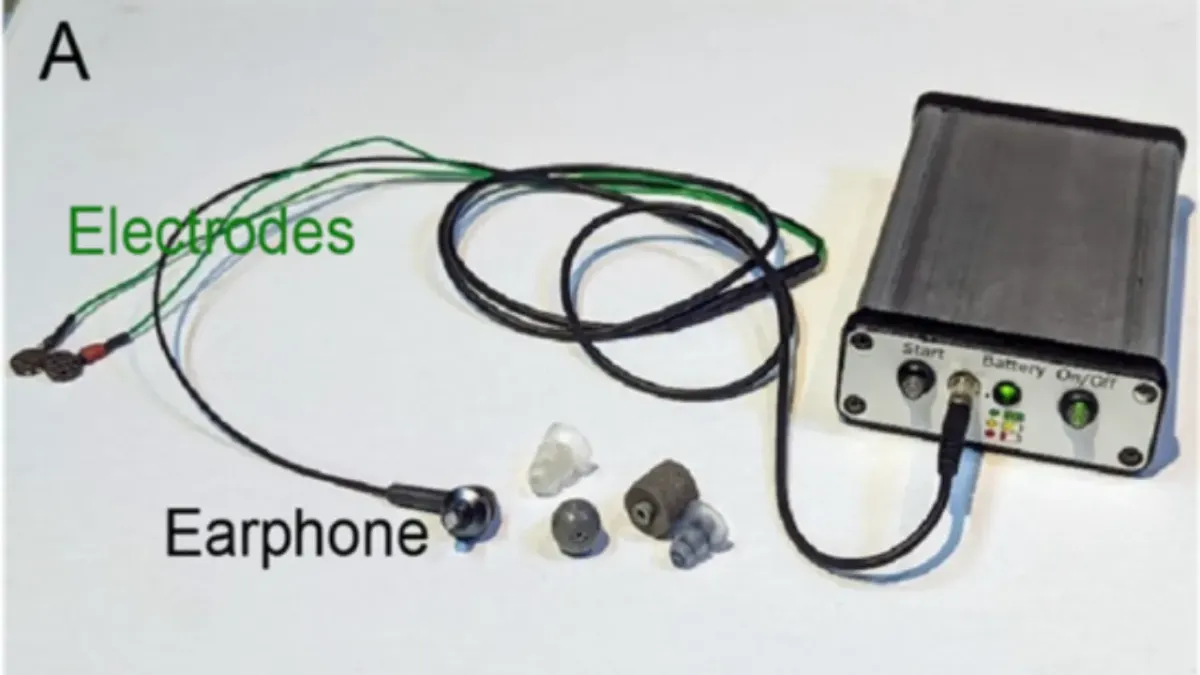
Is the Susan Shore device a game-changer for tinnitus?
There has been much discussion and anticipation in the tinnitus community about the auditory-somatosensory stimulation device being developed by Dr. Susan Shore's team at the University of Michigan. There were some promising preliminary results from a trial published in 2018 involving guinea pigs and humans. But a larger, double-blind, crossover, randomized controlled trial involving 99 participants was published earlier this month in JAMA Network Open. So let's breakdown what this treatment involves and how effective it can be at reducing tinnitus:
1. The device is pictured in this blog post. It consists of an earbud that fits in one ear and electrodes that stick to the skin of the neck or head/face.
2. The study was limited to participants with somatic tinnitus. This means that the people in the study could modulate the sound of their tinnitus by moving their neck, head, jaw, eyes, or tongue in certain ways. This device has not been studied in tinnitus sufferers who cannot modulate their tinnitus in this way.
3. Participants in the treatment arm were advised to wear the device for 30 minutes each day for 6 weeks. During the treatment, sounds are delivered through the earbuds and mild electrical impulses are delivered to the skin through the associated electrodes. The hypothesis was that, when timed in the optimum way, this bimodal stimulation would cause changes in the activity of pathways involving the dorsal cochlear nucleus, resulting in reduced tinnitus.
4. As noted above, the study design was a double-blind, crossover, randomized controlled trial. The primary endpoints being evaluated were the Tinnitus Functional Index (a validated survey tool to measure the severity of tinnitus. The overall score ranges from 0-100 with larger scores associated with more severe tinnitus. A treatment that causes a decrease in TFI of more than 13 points is considered clinically significant) and the tinnitus loudness level (an estimation of the sound intensity of a person's tinnitus in decibels). The secondary endpoint evaluated was the Tinnitus Handicap Inventory (another validated survey tool used to measure how much tinnitus affects a person's quality of life. The score ranges from 0-100 with larger scores associated with more disability from tinnitus. A treatment that causes a decrease in THI of 6 is considered clinically significant by most).
5. The study reported statistically and clinically significant reductions in TFI and tinnitus loudness level after 6 weeks of treatment. They also reported statistically significant reductions in THI after 6 weeks of treatment but those reductions did not quite meet the level of reduction that I consider clinically significant (6 points). These reductions were maintained (and often continued to improve) even 6 weeks after stopping the treatment.
6. There were no severe adverse events (complications) associated with the treatment though four participants withdrew from the study because their tinnitus got worse.
So what do these numbers really mean . . .
This device was able to reduce the severity of tinnitus in most participants with somatic tinnitus. However, the degree of tinnitus improvement, on average, was barely clinically significant. Because this device is quite low risk, I think it may be a good option for many tinnitus sufferers once it becomes commercially available. However, tinnitus sufferers using this device will have to temper their expectations. With the current design, most users can expect meaningful but not dramatic improvements in their tinnitus. If you don't have somatic tinnitus, it is unclear whether this device will offer any benefit.
Another consideration: The sound stimulation coming from the earbuds of this device is delivered at an intensity of 40dB above the auditory threshold at the tinnitus frequency spectrum. Some patients with associated decreased sound tolerance (hyperacusis, misophonia, phonophobia) may find this uncomfortable.



